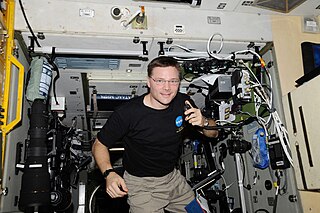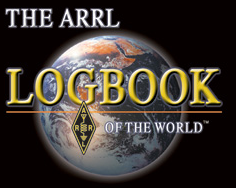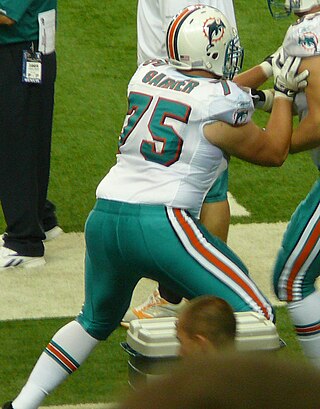The American Radio Relay League (ARRL) is the largest membership association of amateur radio enthusiasts in the United States. ARRL is a non-profit organization, and was co-founded on April 6, 1914, by Hiram Percy Maxim and Clarence D. Tuska of Hartford, Connecticut. The ARRL represents the interests of amateur radio operators before federal regulatory bodies, provides technical advice and assistance to amateur radio enthusiasts, supports a number of educational programs and sponsors emergency communications service throughout the country. The ARRL has approximately 161,000 members. In addition to members in the US, the organization claims over 7,000 members in other countries. The ARRL publishes many books and a monthly membership journal called QST.
In broadcasting and radio communications, a call sign is a unique identifier for a transmitter station. A call sign can be formally assigned by a government agency, informally adopted by individuals or organizations, or even cryptographically encoded to disguise a station's identity.

High-speed multimedia radio (HSMM) is the implementation of high-speed wireless TCP/IP data networks over amateur radio frequency allocations using commercial off-the-shelf (COTS) hardware such as 802.11 Wi-Fi access points. This is possible because the 802.11 unlicensed frequency bands partially overlap with amateur radio bands and ISM bands in many countries. Only licensed amateur radio operators may legally use amplifiers and high-gain antennas within amateur radio frequencies to increase the power and coverage of an 802.11 signal.

An amateur radio station is a radio station designed to provide radiocommunications in the amateur radio service for an amateur radio operator. Radio amateurs build and operate several types of amateur radio stations, including fixed ground stations, mobile stations, space stations, and temporary field stations. A slang term often used for an amateur station's location is the shack, named after the small enclosures added to the upperworks of naval ships to hold early radio equipment and batteries.

Amateur radio international reciprocal operating agreements permit amateur radio operators (hams) from one country to operate a station whilst traveling in another without the need to obtain additional licenses or permits.

In the United States, amateur radio licensing is governed by the Federal Communications Commission (FCC). Licenses to operate amateur stations for personal use are granted to individuals of any age once they demonstrate an understanding of both pertinent FCC regulations and knowledge of radio station operation and safety considerations. Applicants as young as five years old have passed examinations and were granted licenses.

An amateur radio operator is someone who uses equipment at an amateur radio station to engage in two-way personal communications with other amateur operators on radio frequencies assigned to the amateur radio service. Amateur radio operators have been granted an amateur radio license by a governmental regulatory authority after passing an examination on applicable regulations, electronics, radio theory, and radio operation. As a component of their license, amateur radio operators are assigned a call sign that they use to identify themselves during communication. About three million amateur radio operators are currently active worldwide.
Winlink, or formally, Winlink Global Radio Email, also known as the Winlink 2000 Network, is a worldwide radio messaging system that uses amateur-band radio frequencies and government frequencies to provide radio interconnection services that include email with attachments, position reporting, weather bulletins, emergency and relief communications, and message relay. The system is built and administered by volunteers and is financially supported by the Amateur Radio Safety Foundation.

A QSL card is a written confirmation of either a two-way radiocommunication between two amateur radio or citizens band stations; a one-way reception of a signal from an AM radio, FM radio, television or shortwave broadcasting station; or the reception of a two-way radiocommunication by a third party listener. A typical QSL card is the same size and made from the same material as a typical postcard, and most are sent through the mail as such.
The Shuttle Amateur Radio Experiment (SAREX), later called the Space Amateur Radio Experiment, was a program that promoted and supported the use of amateur ("ham") radio by astronauts in low Earth orbit aboard the United States Space Shuttle to communicate with other amateur radio stations around the world. It was superseded by the Amateur Radio on the International Space Station (ARISS) program. SAREX was sponsored by NASA, AMSAT, and the ARRL.

Logbook of the World (LoTW) is a web-accessed database provided by the American Radio Relay League (ARRL) to implement a contact verification service among amateur radio operators. Using LoTW, radio amateurs (hams) can claim and verify contacts (QSOs) made with other amateurs, generally for claiming credit for operating awards, such as DXCC. This kind of verification formerly required exchange of paper QSL cards and submission to ARRL, a slow and somewhat expensive process. LoTW began operation in 2003.
The history of amateur radio, dates from the dawn of radio communications, with published instructions for building simple wireless sets appearing at the beginning of the twentieth century. Throughout its history, amateur radio enthusiasts have made significant contributions to science, engineering, industry, and social services. Research by amateur radio operators has founded new industries, built economies, empowered nations, and saved lives in times of emergency.
Amateur radio or ham radio is practised by more than 22,000 licensed users in India. The first amateur radio operator was licensed in 1921, and by the mid-1930s, there were around 20 amateur radio operators in India. Amateur radio operators played an important part in the Indian independence movement with the establishment of illegal pro-independence radio stations in the 1940s. The three decades after India's independence saw only slow growth in the number of operators until the then Prime Minister of India and amateur radio operator, Rajiv Gandhi (VU2RG), waived the import duty on wireless equipment in 1984. Since then, numbers have picked up, and as of 2007, there were more than 16,000 operators in the country. Amateur radio operators have played a vital role during disasters and national emergencies such as earthquakes, tsunamis, cyclones, floods, and bomb blasts, by providing voluntary emergency communications in the affected areas.

Nathaniel W. Garner is a former Division 1 College & NFL professional American football offensive lineman, who mostly played offensive line, especially tackle. Nate began his career with the University of Arkansas Razorbacks of the NCAA just a few years before being drafted by the New York Jets as the seventh round draft pick of the 2008 NFL Draft. Nate was eventually traded to the Miami Dolphins, where he spent the remainder of his professional playing career.

Amateur radio, also known as ham radio, is the use of the radio frequency spectrum for purposes of non-commercial exchange of messages, wireless experimentation, self-training, private recreation, radiosport, contesting, and emergency communications. The term "amateur" is used to specify "a duly authorized person interested in radioelectric practice with a purely personal aim and without pecuniary interest"; and to differentiate it from commercial broadcasting, public safety, or professional two-way radio services.
Amateur radio call signs in Africa are codes used to identify all radio communications, broadcasts and transmissions. The International Telecommunication Union assigns Africa as ITU region #1. It has assigned call signs prefix blocks to countries including 77 DXCC entities in and off-shore of Africa. Western Sahara is not a DXCC entity but uses SØ as a prefix.
Amateur radio call signs are allocated to amateur radio operators around the world. The call signs are used to legally identify the station or operator, with some countries requiring the station call sign to always be used and others allowing the operator call sign instead.
Call signs in Antarctica include a three letter region code and a series of numbers and letters.
Call signs in United Kingdom include a three letter country code, and a series of letters and numbers.
Broadcast call signs are call signs assigned as unique identifiers to radio stations and television stations. While broadcast radio stations will often brand themselves with plain-text names, identities such as "cool FM", "rock 105" or "the ABC network" are not globally unique. Another station in another city or country may have a similar brand, and the name of a broadcast station for legal purposes is normally its internationally recognised ITU call sign. Some common conventions are followed around the world.








